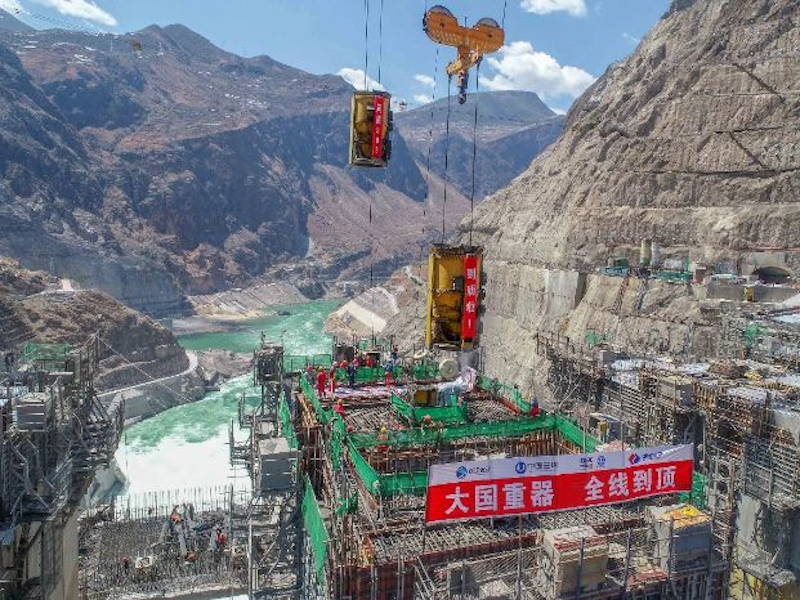The Wudongde hydropower project is 10.2GW hydroelectric facility under construction on the lower reaches of the Jhinsa River on the border of Sichuan and Yunnan provinces in southwest China. It started generating power with the commissioning of the first generating unit in June 2020.
Upon commissioning of all 12 generating units by the end of 2021, Wudongde will be the fourth biggest hydroelectric power station in China and the seventh biggest in the world.
The £10.4bn ($15.5bn) project is being developed by Jhinsa River Yunchuan Hydropower Development Company, a joint-venture of China Three Gorges Corporation ( CTG, 70%), Sichuan Province (15%) and Yunnan Province (15%). CTG is the operator of the facility.
At full capacity, the Wudongde hydroelectric facility is expected to generate 38.9 terawatt-hours (TWh) of electricity, while offsetting approximately 30.5 million tonnes (Mt) of CO2 emissions a year.
Project location and development background
The massive Wudongde hydropower station is located on the downstream of the Jhinsa River with its left bank powerhouse located in the Huidong County of Sichuan Province and the right bank powerhouse in the Luquan County of Yunnan Province.
Wudongde is one of the four cascade hydropower stations located on the lower reaches of the Jhinsa River with a combined installed capacity of approximately 46GW.
The other three projects are the under construction 16GW Baihetan hydropower station, and the 13.86GW Xiluodu hydropower station and the 6.4GW Xiangjiaba hydropower station that have been operational since 2013 and 2012, respectively. The Wudongde project is located upstream of these three projects.
The Wudongde project along with the Baihetan project is intended to facilitate the West-East power transmission programme in China that aims to transfer electricity from west China to the Guangdong province in east China.
The preparatory works for the Wudongde hydropower project were started in 2011 while the main construction works were started in the second half of 2015.
The Wundongde hydroelectric power project is being supported by the China Clean Development Mechanism (CDM) Fund.
Wudongde hydroelectric facility make-up
The Wudongde hydroelectric power station comprises a 270m-tall concrete double-curvature arch dam with 988m crest elevation and 51m-thick foundation bed, and two underground powerhouses on both sides of the river with 5.1GW installed capacity each.
Measuring 333m-long, 32.5m-wide, and 89.8m-high, each underground powerhouse will be equipped with six 850MW Francis turbine-generator units.
The Wudongde dam is claimed to be one of the smartest dams in the world. The dam structure is made of low-heat cement to withstand large temperature differences and prevent cracking. The concrete structure of the dam has been embedded with thermometers and cooling pipes to detect the temperature in real-time.
The project utilises cutting-edge intelligent technologies to automatically adjust the water flow to regulate the cooling process of concrete.
Reservoir details
The Wudongde dam, with an impoundment level of approximately 975m, creates a reservoir with a total storage capacity of 7.4 billion cubic metres (bcm) with 3.02bcm of regulation storage capacity and 2.44bcm of flood control storage capacity.
The flood discharge structure comprises five surface holes and six middle openings on the dam body, and three non-pressure spillway tunnels with crimp connection on the left bank. The total flood discharge capacity of the reservoir will be 39,444m³/s.
Contractors involved
China Three Gorges Corporation (CTGC) was responsible for the dam construction of the Wudongde hydropower project.
Voith received an order worth £284.00 ($411.29m) to supply six Francis turbine-generator units along with auxiliary parts for the Wudongde hydropower project in March 2016.
GE was contracted to supply the other six hydroelectric turbine generator units and auxiliary parts for the project in December 2015.
AZZ, a specialty electrical equipment manufacturer, was contracted to supply six circuits of 550kV 4,000Amp gas-insulated line (GIL) for a total length of 8.9km, three circuits for each vertical shaft of the power station in February 2017.





